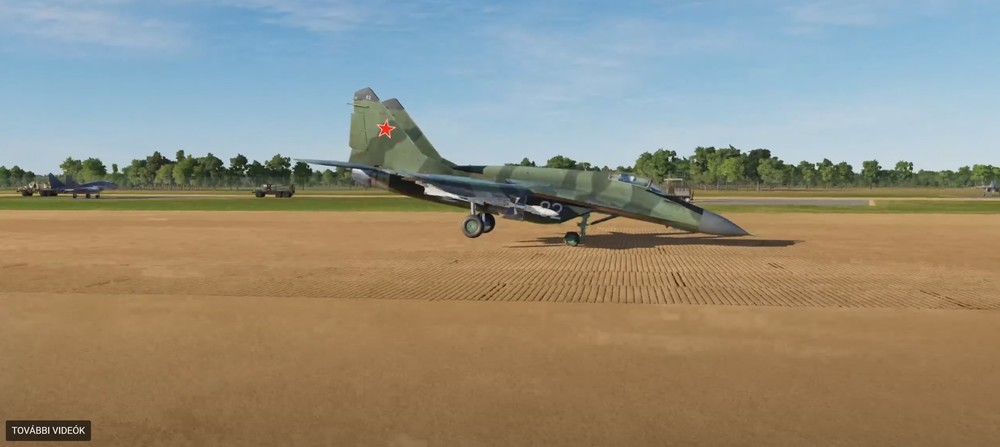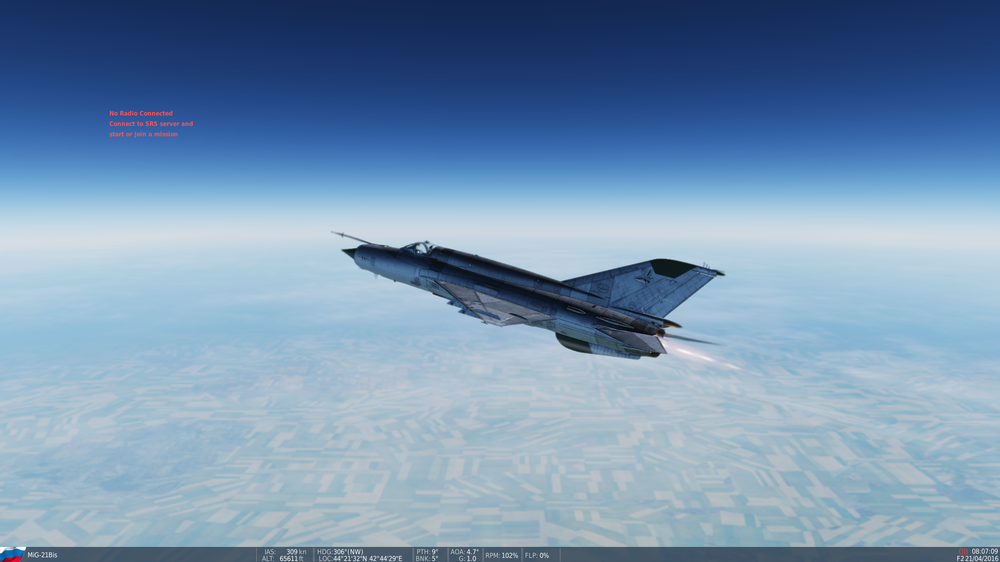

HWasp
Members-
Posts
645 -
Joined
-
Last visited
Content Type
Profiles
Forums
Events
Everything posted by HWasp
-
It's been demonstrated over and over again, that if you do a proper landing, and dont smash your nose gear onto the runway, there will be no bounce, it is perfectly safe. https://forums.eagle.ru/showpost.php?p=4411049&postcount=56 I'm not saying that the nose gear shouldn't be looked at, but the new players, instead of "turning away" should learn to land properly, not just fly into the runway at ridicolous speeds and attitudes...
-
Interesting! So around 4,5 G was the impact. That is a lot.
-
No, of course not. Sorry I don't want to make your flying look bad, just that screen looks like a good illustration to me.
-
Yes, exactly, but I think that this is the point, at moment of the attached screenshot, where this flight should end in flames. Just before the last bounce. I'd be amazed of the front gear survived something like this RL. Picture shows the impact after the second bounce.
-
Wow that was scary. :thumbup: That Sukhoi did not bounce it's nose gear though, so it is very different scenario. If you watch your 29S video, what happens is that after the first impact it bounces off the main wheels, but not high, after that your plane touches down nose first and bounces off the nose gear, sending the nose high nose high--->high AoA (you are still going fast)----> lift is produced--> bigger bounce On the third impact, I think that your nose gear should simply collapse...
-
The MiG-29K video shows the kind of landing you did in DCS regarding the vertical speed on touch down.
-
Love that MiG-21 video, it's awesome, really shows how durable that plane is Back on the subject, a 5 m/s vs landing means smashing the plane on the runway with no flare at all. That is clearly not what happens in the 29 cockpit videos. The VSI won't show you an exact history of what happened. Also you are watching it from a different position in the vid so it's not even accurate, but if you watch it closely it shows aroud -2 around the touch down.
-
You can't tell exactly, it is impossible, because VSI has a delay, so that it reads 5 m/s during the approach gives you zero information about the actual touch down descent rate. 5 m/s is already quite a lot for touch down rate, you'd certainly notice even just looking at the vid. Thats the kind of touch down vertical speed you can see on a youtube hard landing vid, you know, big bang, passengers shouting :)
-
No, his actual touch down vertical speed is nowhere near 5 m/s. That is a very smooth landing where you can hear, that he only reduces to idle right after the touch down
-
If I stop your MiG-29S video right before the touch down at 1:24, in the last second: PTH (Pitch) = 5 degrees AoA = 10 degrees (9.9) That means that you actual flight path in the last moment is 5 degrees steep! (3 degrees is the ususal ILS appoach GS) So instead of flaring your vertical speed increases a LOT just before touch down. Might be wrong but I think your actual touch down vertical speed in that vid is 6.7 m/s or 1320 feet/minute. Thats kinda too much for a carrier landing imo...
-
I think maybe he is just boasting a bit. You see the setup, he seems to be talking to a group of normal average civilians, that is perfectly normal in my view. Chances are if he was interviewed as an SME, then we would get more detailed info on the matter, which of course might be little different than our sim, because different version and inaccuracies in the sim, but most certainly not something extreme like 60 degrees all the way and not loosing speed... Thats why it is important to crosscheck info, and think, even if it comes from a really respectable source, like that man.
-
IMO the illogical thing is to keep claiming the DCS MiG-21 should have more than twice the engine power over and over again, even if the numbers just won't add up, and the plane meets all the performace data, like maximum speed, acceleration and max. altitude. https://forums.eagle.ru/showpost.php?p=3457419&postcount=2 Here is the link to the RL MiG-21bis manual, feel free to dig up data that supports that insane climb performance you claim to be realistic, and file a bug report to the devs. Good luck :)
-
You know, pilots are human beings, even fighter pilots, and it is possible that what they say is not always 100% accurate. Look, jet engine's thrust decreases with altitude, as the air gets thinner, there is just less oxygen to work with, so less fuel can be burned so less thrust is available. You'll end up with less than half of the sea level thrust by the time you reach 10km If you have the DCS F-15 or F-16, take them for a ride and watch the fuel flow indicator as you do a steep climb! Thrust produced is proportional to fuel flow, so you can see it for yourself for better understanding. Also that might show you, that what you expect here is too much even for a F15 or F16. For the 21 to be able to climb like you say all the way to 10km, it would need to have at least twice the engine thrust BTW I hope you know that Dolphin, the dev for the DCS 21 is also an IRL MiG-21bis pilot...
-
Ok, first of all, thanks for the video, very interesting, will watch the whole thing when I have the time. On the other hand it is ridiculous to claim that our DCS MiG-21 is completely wrong based on a single sentence in a foreign language video translated by youtube translator and smartphone translator. Especially since the module performance matches many other things he says. 60 degrees pitch is possible only for the initial climb, if you don't want to loose airspeed.
-
Good try, but you didn't meet the Mach 2 criteria. My time still stands. :)
-
It is said? Where did you read that? Why don't you start up your DCS, hop into a MiG-21 and see it for yourself? What happens in DCS is that you reach Mach 1 in even less than 60 seconds, then you can pitch up to 60 and the plane will hold it's speed decently up to 4000 meters, where the emergency afterburner cuts out, and then if you still force the 60 degrees pitch, then you loose all your speed before reaching 10000m 21bis thrust without emergency afterburner is 69KN at sea level, then at like 6000 m it will be only around 60% of that (41KN) while the plane is around 8000kg in that scenario. So your thrust to weight ratio will reduce to 0,5 by the time you pass even 6000m and it will decrease further as you go higher. (Didn't account for the effect of airspeed and thrust loss is just data for generic jet engine, so obviously these are just ballpark figures) Do you understand now, why the 60 degrees climb all the way is nonsense? Even a clean F-16 starts to loose speed over 6000m in that climb
-
Post track or tacview please!
-
Well, Mach2 at 20000m was the task, I guess you passed that at some point if you climbed to 100k feet. You'll need to provide a track though.
-
MiG-29 maybe lol.... You might have misunderstood something, but it's not important anyway. There is the track, and 6:38 is the new time to beat :) (keep it at 15 celsius) (timer stopped when cockpit altimeter read 20000m)
-
-
Just did it in 6 minutes and 38 seconds. Temperature was set to 15 celsius. Did my own custom profile though as it is more effective. 60 deg climb is waaay too steep for the 21 and it is better to accelerate lower (around 7000m) and in a shallow descent up to Mach 1.4. Subsonic below 10000m is a peacetime regulation so that you don't brake too many windows :) MiG-21 7minute climb.trk
-
Sorry if I sound rude, but my advice is, that if someone can't do AAR or carrier landing, and is not willing to learn it: Simply don't do AAR and don't do carrier ops. Have fun with everything else. I get it, that lots of people don't have the free time to learn and practice, but then, why fly a 2 hour long boring mission with AAR? Don't get me wrong, I'm not against people playing the game their own way, my problem is that there are 1000 more important things I'd like ED to work on instead...
-
Correct me if I'm wrong, but Aim-7 is around 230 kg while R-27R is 250kg. Why do you consider it HEAVY with capital letters?
-
F-14 vs MiG-23 1v1 is not a fair fight, the F-14 is clearly better in both BVR and WVR, there is nothing to argue... BUT Wiki says that an F-14A in 1977 cost 19.2 million USD, while the MiG-23 between 3.6 to 6.6 million If that is accurate, then you could buy 3-5 MiG-23 for the price of 1 F-14A, and production numbers reflect that. Based on that I'd say that a 1v4 scenario should be considered when talking about MiG-23 vs US 4th gens like the F-14 or the F-15
-
If you don't post a track or at least a screenshot, nobody can help you


